FNSACC502 Diploma of Accounting: Income Tax Returns - Task 1
VerifiedAdded on 2023/06/10
|20
|4625
|77
Homework Assignment
AI Summary
This document presents a solution to an assessment task for the FNSACC502 unit, which focuses on preparing income tax returns for individuals. The assessment includes questions related to defining assessable income according to the Income Tax Assessment Act 1997, providing examples of ordinary and statutory income, describing different types of audits conducted by the ATO, outlining the key differences between residents and non-residents for tax purposes, explaining the exhaustive tests of residence for individuals as per Section 6(1) of the ITAA 1936, detailing the core principles of the Tax Agent Services Act 2009, providing examples of conflict management arrangements for tax practitioners, addressing ethical dilemmas faced by tax practitioners, specifying the record-keeping requirements for taxpayers, and determining correct lodgment dates for various scenarios. The solution also includes student and assessor declarations, assessment conditions, and references to relevant legislation and resources.
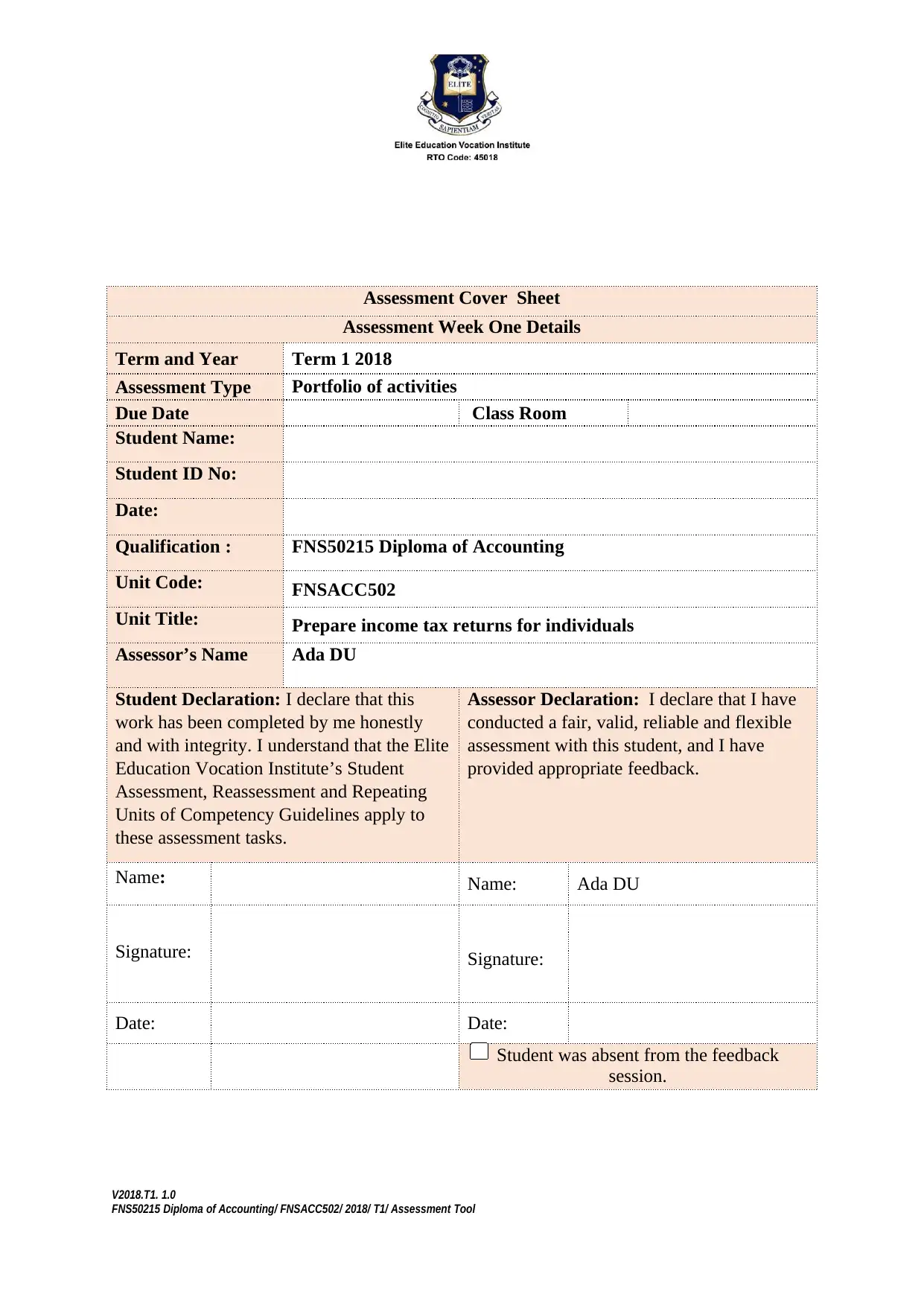
Assessment Cover Sheet
Assessment Week One Details
Term and Year Term 1 2018
Assessment Type Portfolio of activities
Due Date Class Room
Student Name:
Student ID No:
Date:
Qualification : FNS50215 Diploma of Accounting
Unit Code: FNSACC502
Unit Title: Prepare income tax returns for individuals
Assessor’s Name Ada DU
Student Declaration: I declare that this
work has been completed by me honestly
and with integrity. I understand that the Elite
Education Vocation Institute’s Student
Assessment, Reassessment and Repeating
Units of Competency Guidelines apply to
these assessment tasks.
Assessor Declaration: I declare that I have
conducted a fair, valid, reliable and flexible
assessment with this student, and I have
provided appropriate feedback.
Name: Name: Ada DU
Signature: Signature:
Date: Date:
Student was absent from the feedback
session.
V2018.T1. 1.0
FNS50215 Diploma of Accounting/ FNSACC502/ 2018/ T1/ Assessment Tool
Assessment Week One Details
Term and Year Term 1 2018
Assessment Type Portfolio of activities
Due Date Class Room
Student Name:
Student ID No:
Date:
Qualification : FNS50215 Diploma of Accounting
Unit Code: FNSACC502
Unit Title: Prepare income tax returns for individuals
Assessor’s Name Ada DU
Student Declaration: I declare that this
work has been completed by me honestly
and with integrity. I understand that the Elite
Education Vocation Institute’s Student
Assessment, Reassessment and Repeating
Units of Competency Guidelines apply to
these assessment tasks.
Assessor Declaration: I declare that I have
conducted a fair, valid, reliable and flexible
assessment with this student, and I have
provided appropriate feedback.
Name: Name: Ada DU
Signature: Signature:
Date: Date:
Student was absent from the feedback
session.
V2018.T1. 1.0
FNS50215 Diploma of Accounting/ FNSACC502/ 2018/ T1/ Assessment Tool
Paraphrase This Document
Need a fresh take? Get an instant paraphrase of this document with our AI Paraphraser
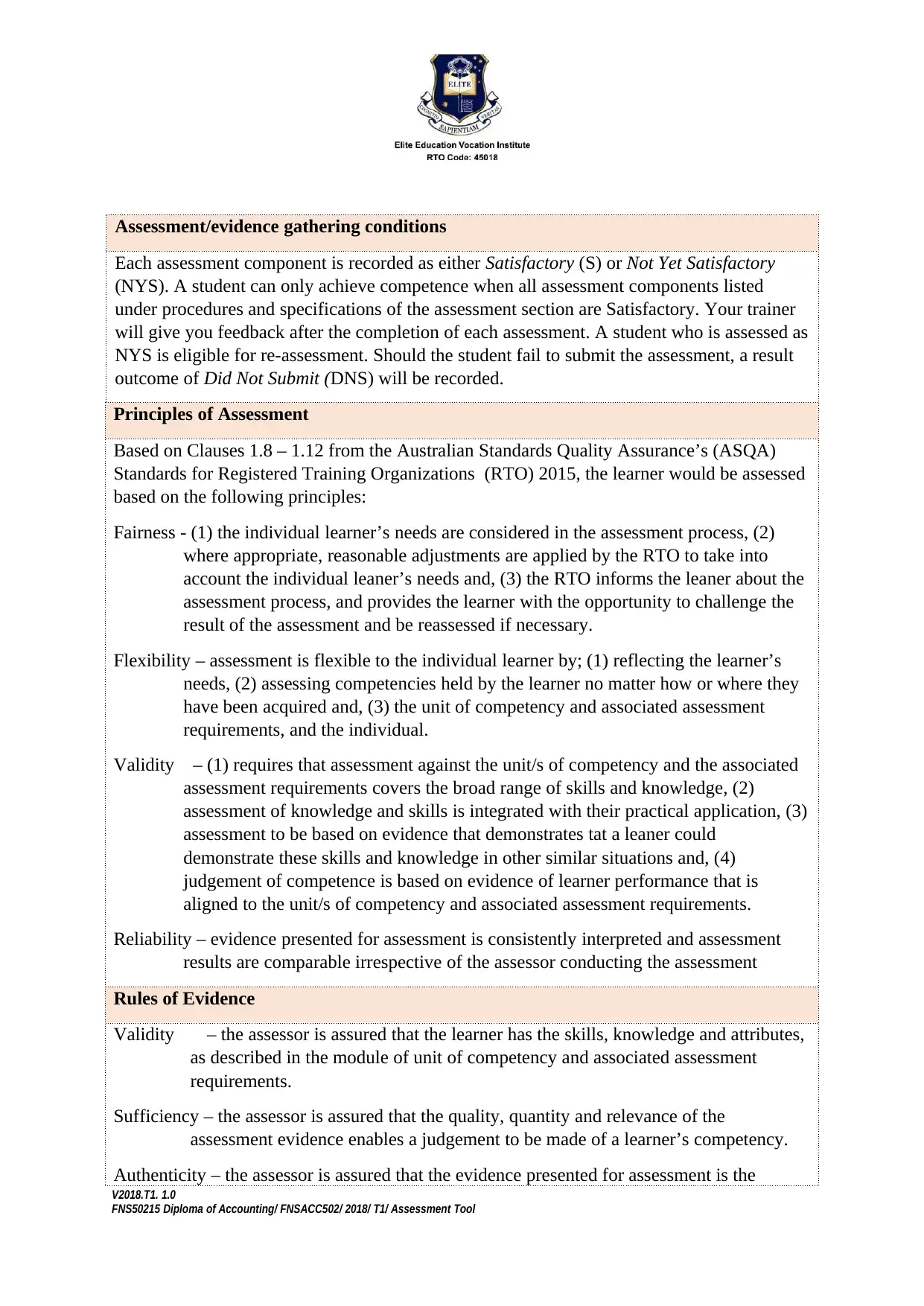
Assessment/evidence gathering conditions
Each assessment component is recorded as either Satisfactory (S) or Not Yet Satisfactory
(NYS). A student can only achieve competence when all assessment components listed
under procedures and specifications of the assessment section are Satisfactory. Your trainer
will give you feedback after the completion of each assessment. A student who is assessed as
NYS is eligible for re-assessment. Should the student fail to submit the assessment, a result
outcome of Did Not Submit (DNS) will be recorded.
Principles of Assessment
Based on Clauses 1.8 – 1.12 from the Australian Standards Quality Assurance’s (ASQA)
Standards for Registered Training Organizations (RTO) 2015, the learner would be assessed
based on the following principles:
Fairness - (1) the individual learner’s needs are considered in the assessment process, (2)
where appropriate, reasonable adjustments are applied by the RTO to take into
account the individual leaner’s needs and, (3) the RTO informs the leaner about the
assessment process, and provides the learner with the opportunity to challenge the
result of the assessment and be reassessed if necessary.
Flexibility – assessment is flexible to the individual learner by; (1) reflecting the learner’s
needs, (2) assessing competencies held by the learner no matter how or where they
have been acquired and, (3) the unit of competency and associated assessment
requirements, and the individual.
Validity – (1) requires that assessment against the unit/s of competency and the associated
assessment requirements covers the broad range of skills and knowledge, (2)
assessment of knowledge and skills is integrated with their practical application, (3)
assessment to be based on evidence that demonstrates tat a leaner could
demonstrate these skills and knowledge in other similar situations and, (4)
judgement of competence is based on evidence of learner performance that is
aligned to the unit/s of competency and associated assessment requirements.
Reliability – evidence presented for assessment is consistently interpreted and assessment
results are comparable irrespective of the assessor conducting the assessment
Rules of Evidence
Validity – the assessor is assured that the learner has the skills, knowledge and attributes,
as described in the module of unit of competency and associated assessment
requirements.
Sufficiency – the assessor is assured that the quality, quantity and relevance of the
assessment evidence enables a judgement to be made of a learner’s competency.
Authenticity – the assessor is assured that the evidence presented for assessment is the
V2018.T1. 1.0
FNS50215 Diploma of Accounting/ FNSACC502/ 2018/ T1/ Assessment Tool
Each assessment component is recorded as either Satisfactory (S) or Not Yet Satisfactory
(NYS). A student can only achieve competence when all assessment components listed
under procedures and specifications of the assessment section are Satisfactory. Your trainer
will give you feedback after the completion of each assessment. A student who is assessed as
NYS is eligible for re-assessment. Should the student fail to submit the assessment, a result
outcome of Did Not Submit (DNS) will be recorded.
Principles of Assessment
Based on Clauses 1.8 – 1.12 from the Australian Standards Quality Assurance’s (ASQA)
Standards for Registered Training Organizations (RTO) 2015, the learner would be assessed
based on the following principles:
Fairness - (1) the individual learner’s needs are considered in the assessment process, (2)
where appropriate, reasonable adjustments are applied by the RTO to take into
account the individual leaner’s needs and, (3) the RTO informs the leaner about the
assessment process, and provides the learner with the opportunity to challenge the
result of the assessment and be reassessed if necessary.
Flexibility – assessment is flexible to the individual learner by; (1) reflecting the learner’s
needs, (2) assessing competencies held by the learner no matter how or where they
have been acquired and, (3) the unit of competency and associated assessment
requirements, and the individual.
Validity – (1) requires that assessment against the unit/s of competency and the associated
assessment requirements covers the broad range of skills and knowledge, (2)
assessment of knowledge and skills is integrated with their practical application, (3)
assessment to be based on evidence that demonstrates tat a leaner could
demonstrate these skills and knowledge in other similar situations and, (4)
judgement of competence is based on evidence of learner performance that is
aligned to the unit/s of competency and associated assessment requirements.
Reliability – evidence presented for assessment is consistently interpreted and assessment
results are comparable irrespective of the assessor conducting the assessment
Rules of Evidence
Validity – the assessor is assured that the learner has the skills, knowledge and attributes,
as described in the module of unit of competency and associated assessment
requirements.
Sufficiency – the assessor is assured that the quality, quantity and relevance of the
assessment evidence enables a judgement to be made of a learner’s competency.
Authenticity – the assessor is assured that the evidence presented for assessment is the
V2018.T1. 1.0
FNS50215 Diploma of Accounting/ FNSACC502/ 2018/ T1/ Assessment Tool
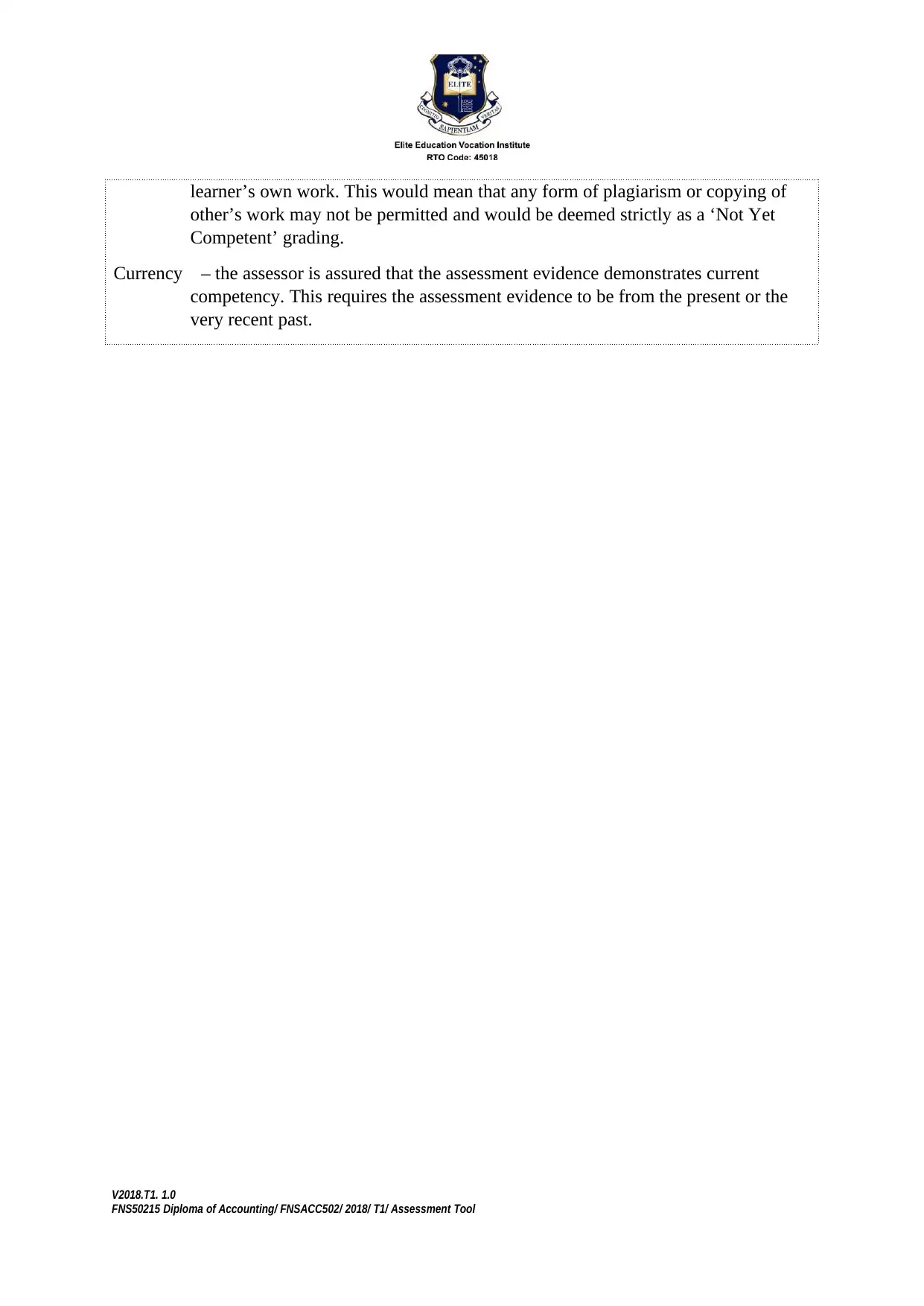
learner’s own work. This would mean that any form of plagiarism or copying of
other’s work may not be permitted and would be deemed strictly as a ‘Not Yet
Competent’ grading.
Currency – the assessor is assured that the assessment evidence demonstrates current
competency. This requires the assessment evidence to be from the present or the
very recent past.
V2018.T1. 1.0
FNS50215 Diploma of Accounting/ FNSACC502/ 2018/ T1/ Assessment Tool
other’s work may not be permitted and would be deemed strictly as a ‘Not Yet
Competent’ grading.
Currency – the assessor is assured that the assessment evidence demonstrates current
competency. This requires the assessment evidence to be from the present or the
very recent past.
V2018.T1. 1.0
FNS50215 Diploma of Accounting/ FNSACC502/ 2018/ T1/ Assessment Tool
⊘ This is a preview!⊘
Do you want full access?
Subscribe today to unlock all pages.

Trusted by 1+ million students worldwide
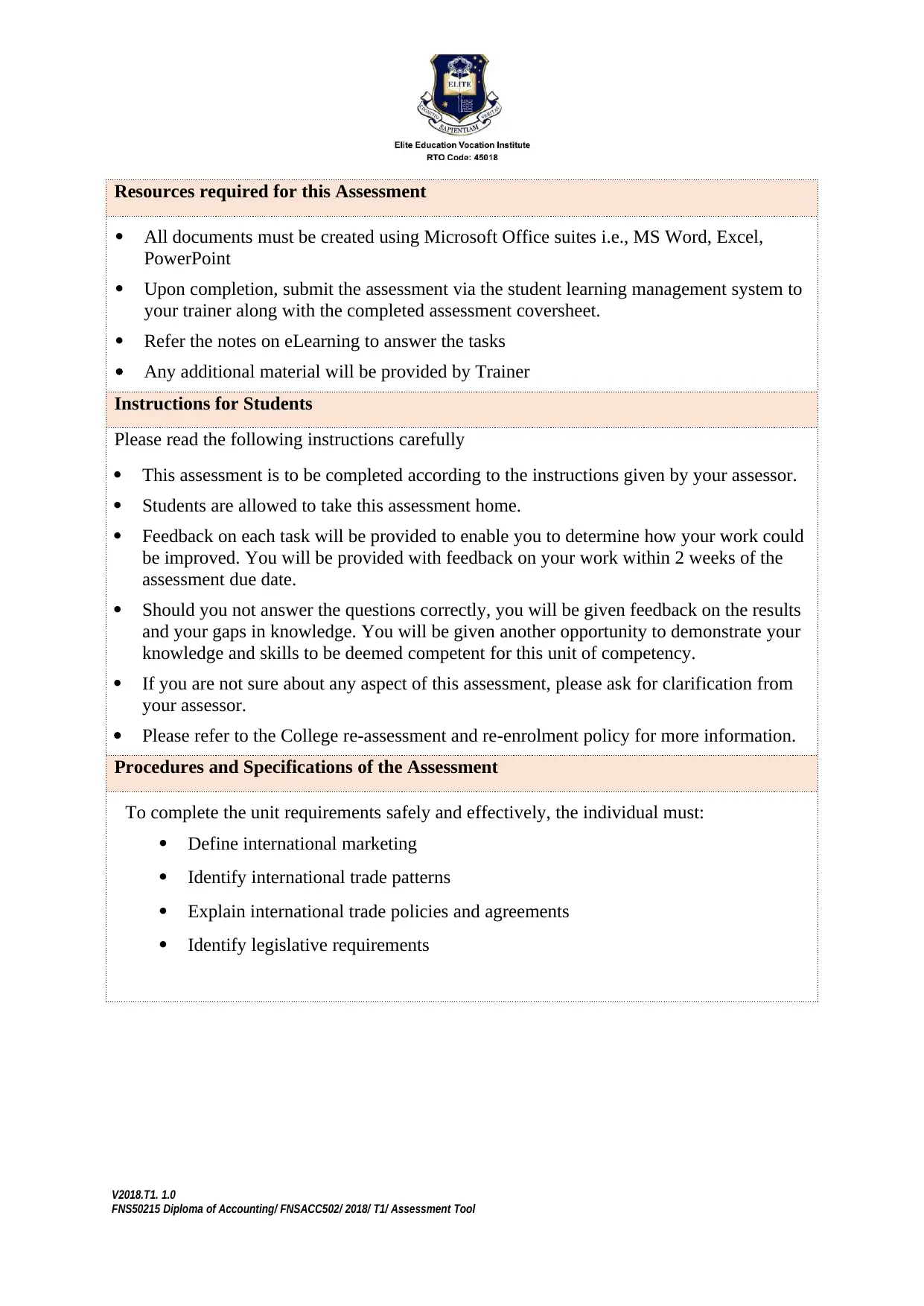
Resources required for this Assessment
All documents must be created using Microsoft Office suites i.e., MS Word, Excel,
PowerPoint
Upon completion, submit the assessment via the student learning management system to
your trainer along with the completed assessment coversheet.
Refer the notes on eLearning to answer the tasks
Any additional material will be provided by Trainer
Instructions for Students
Please read the following instructions carefully
This assessment is to be completed according to the instructions given by your assessor.
Students are allowed to take this assessment home.
Feedback on each task will be provided to enable you to determine how your work could
be improved. You will be provided with feedback on your work within 2 weeks of the
assessment due date.
Should you not answer the questions correctly, you will be given feedback on the results
and your gaps in knowledge. You will be given another opportunity to demonstrate your
knowledge and skills to be deemed competent for this unit of competency.
If you are not sure about any aspect of this assessment, please ask for clarification from
your assessor.
Please refer to the College re-assessment and re-enrolment policy for more information.
Procedures and Specifications of the Assessment
To complete the unit requirements safely and effectively, the individual must:
Define international marketing
Identify international trade patterns
Explain international trade policies and agreements
Identify legislative requirements
V2018.T1. 1.0
FNS50215 Diploma of Accounting/ FNSACC502/ 2018/ T1/ Assessment Tool
All documents must be created using Microsoft Office suites i.e., MS Word, Excel,
PowerPoint
Upon completion, submit the assessment via the student learning management system to
your trainer along with the completed assessment coversheet.
Refer the notes on eLearning to answer the tasks
Any additional material will be provided by Trainer
Instructions for Students
Please read the following instructions carefully
This assessment is to be completed according to the instructions given by your assessor.
Students are allowed to take this assessment home.
Feedback on each task will be provided to enable you to determine how your work could
be improved. You will be provided with feedback on your work within 2 weeks of the
assessment due date.
Should you not answer the questions correctly, you will be given feedback on the results
and your gaps in knowledge. You will be given another opportunity to demonstrate your
knowledge and skills to be deemed competent for this unit of competency.
If you are not sure about any aspect of this assessment, please ask for clarification from
your assessor.
Please refer to the College re-assessment and re-enrolment policy for more information.
Procedures and Specifications of the Assessment
To complete the unit requirements safely and effectively, the individual must:
Define international marketing
Identify international trade patterns
Explain international trade policies and agreements
Identify legislative requirements
V2018.T1. 1.0
FNS50215 Diploma of Accounting/ FNSACC502/ 2018/ T1/ Assessment Tool
Paraphrase This Document
Need a fresh take? Get an instant paraphrase of this document with our AI Paraphraser
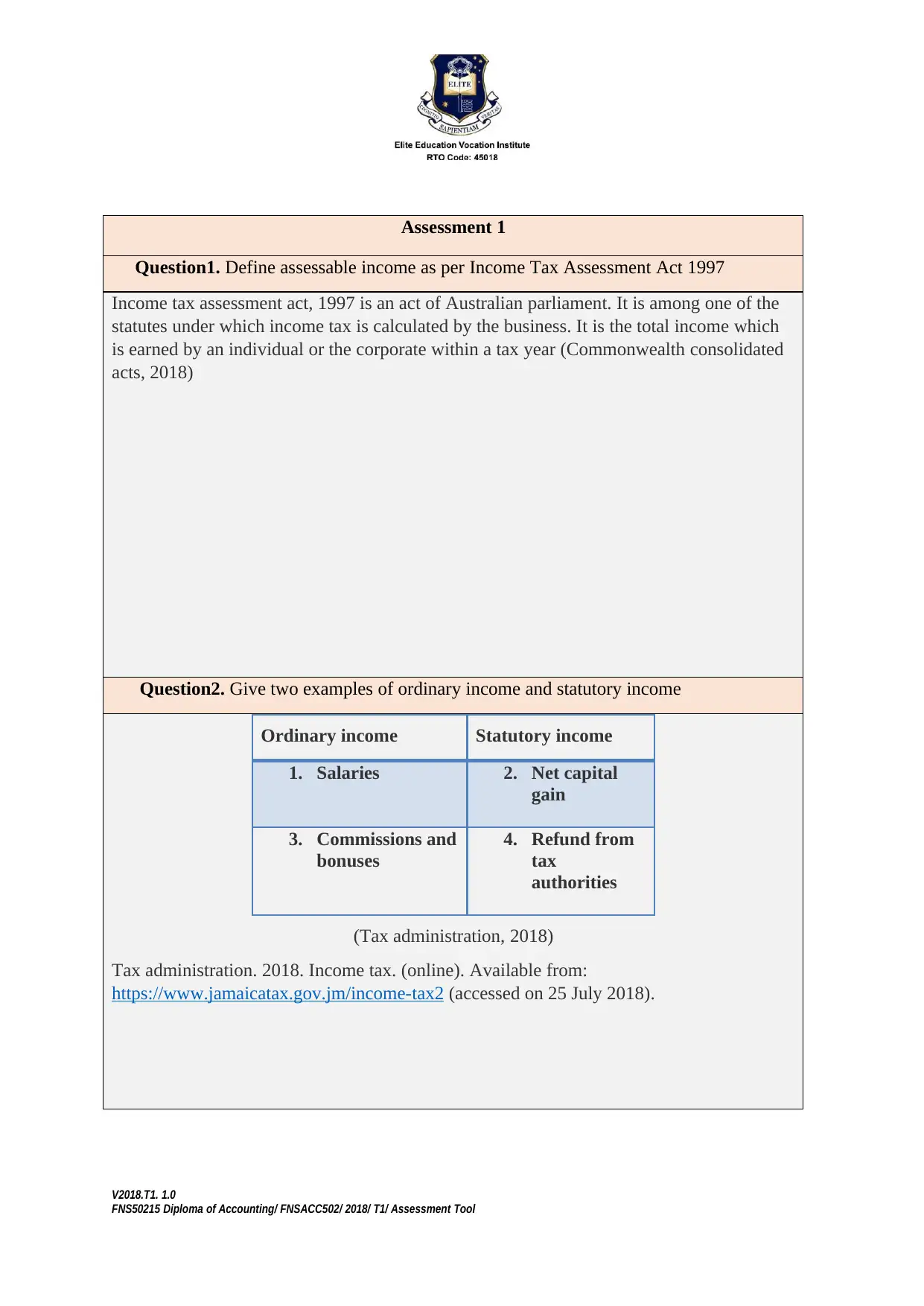
Assessment 1
Question1. Define assessable income as per Income Tax Assessment Act 1997
Income tax assessment act, 1997 is an act of Australian parliament. It is among one of the
statutes under which income tax is calculated by the business. It is the total income which
is earned by an individual or the corporate within a tax year (Commonwealth consolidated
acts, 2018)
Question2. Give two examples of ordinary income and statutory income
Ordinary income Statutory income
1. Salaries 2. Net capital
gain
3. Commissions and
bonuses
4. Refund from
tax
authorities
(Tax administration, 2018)
Tax administration. 2018. Income tax. (online). Available from:
https://www.jamaicatax.gov.jm/income-tax2 (accessed on 25 July 2018).
V2018.T1. 1.0
FNS50215 Diploma of Accounting/ FNSACC502/ 2018/ T1/ Assessment Tool
Question1. Define assessable income as per Income Tax Assessment Act 1997
Income tax assessment act, 1997 is an act of Australian parliament. It is among one of the
statutes under which income tax is calculated by the business. It is the total income which
is earned by an individual or the corporate within a tax year (Commonwealth consolidated
acts, 2018)
Question2. Give two examples of ordinary income and statutory income
Ordinary income Statutory income
1. Salaries 2. Net capital
gain
3. Commissions and
bonuses
4. Refund from
tax
authorities
(Tax administration, 2018)
Tax administration. 2018. Income tax. (online). Available from:
https://www.jamaicatax.gov.jm/income-tax2 (accessed on 25 July 2018).
V2018.T1. 1.0
FNS50215 Diploma of Accounting/ FNSACC502/ 2018/ T1/ Assessment Tool
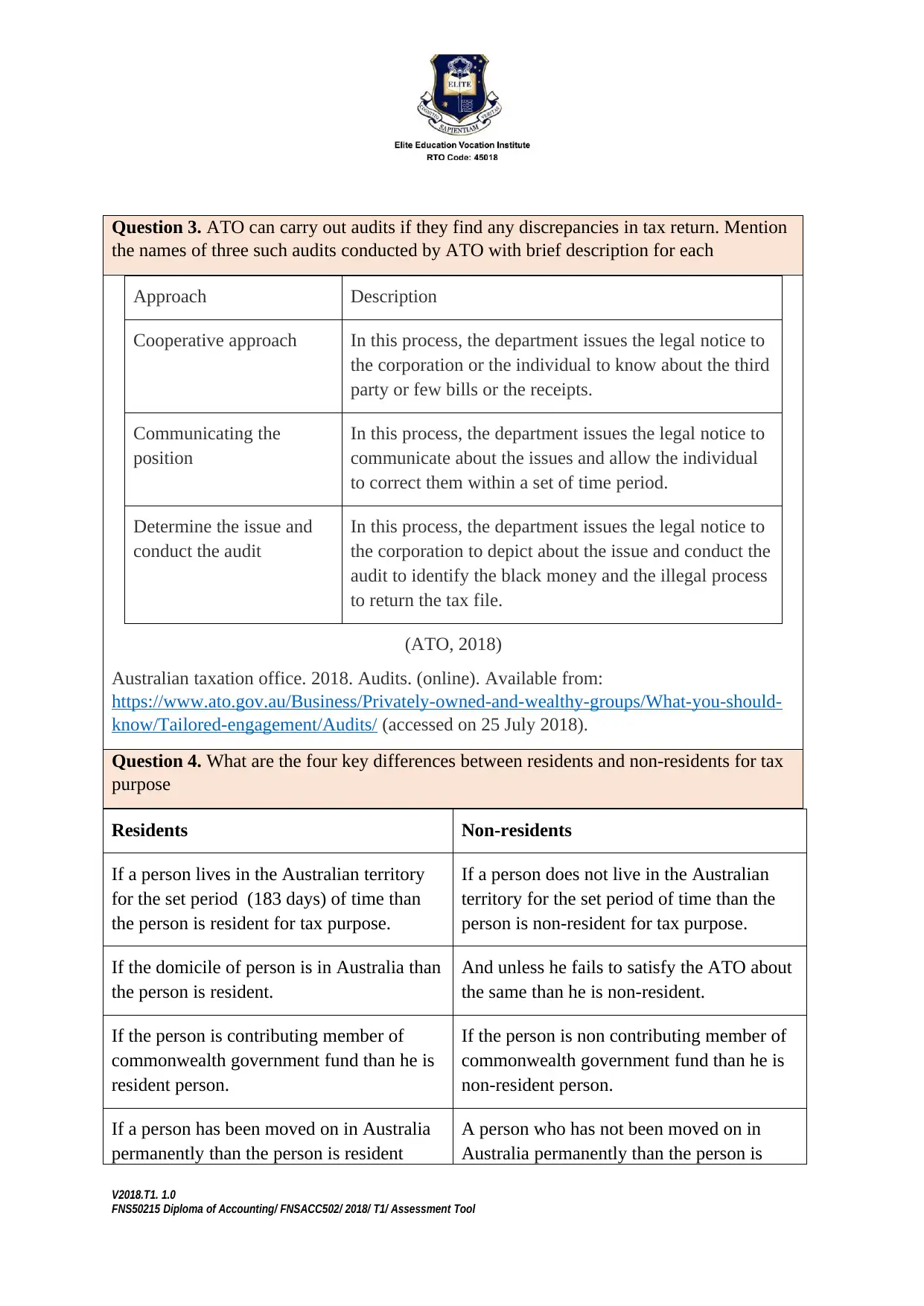
Question 3. ATO can carry out audits if they find any discrepancies in tax return. Mention
the names of three such audits conducted by ATO with brief description for each
Approach Description
Cooperative approach In this process, the department issues the legal notice to
the corporation or the individual to know about the third
party or few bills or the receipts.
Communicating the
position
In this process, the department issues the legal notice to
communicate about the issues and allow the individual
to correct them within a set of time period.
Determine the issue and
conduct the audit
In this process, the department issues the legal notice to
the corporation to depict about the issue and conduct the
audit to identify the black money and the illegal process
to return the tax file.
(ATO, 2018)
Australian taxation office. 2018. Audits. (online). Available from:
https://www.ato.gov.au/Business/Privately-owned-and-wealthy-groups/What-you-should-
know/Tailored-engagement/Audits/ (accessed on 25 July 2018).
Question 4. What are the four key differences between residents and non-residents for tax
purpose
Residents Non-residents
If a person lives in the Australian territory
for the set period (183 days) of time than
the person is resident for tax purpose.
If a person does not live in the Australian
territory for the set period of time than the
person is non-resident for tax purpose.
If the domicile of person is in Australia than
the person is resident.
And unless he fails to satisfy the ATO about
the same than he is non-resident.
If the person is contributing member of
commonwealth government fund than he is
resident person.
If the person is non contributing member of
commonwealth government fund than he is
non-resident person.
If a person has been moved on in Australia
permanently than the person is resident
A person who has not been moved on in
Australia permanently than the person is
V2018.T1. 1.0
FNS50215 Diploma of Accounting/ FNSACC502/ 2018/ T1/ Assessment Tool
the names of three such audits conducted by ATO with brief description for each
Approach Description
Cooperative approach In this process, the department issues the legal notice to
the corporation or the individual to know about the third
party or few bills or the receipts.
Communicating the
position
In this process, the department issues the legal notice to
communicate about the issues and allow the individual
to correct them within a set of time period.
Determine the issue and
conduct the audit
In this process, the department issues the legal notice to
the corporation to depict about the issue and conduct the
audit to identify the black money and the illegal process
to return the tax file.
(ATO, 2018)
Australian taxation office. 2018. Audits. (online). Available from:
https://www.ato.gov.au/Business/Privately-owned-and-wealthy-groups/What-you-should-
know/Tailored-engagement/Audits/ (accessed on 25 July 2018).
Question 4. What are the four key differences between residents and non-residents for tax
purpose
Residents Non-residents
If a person lives in the Australian territory
for the set period (183 days) of time than
the person is resident for tax purpose.
If a person does not live in the Australian
territory for the set period of time than the
person is non-resident for tax purpose.
If the domicile of person is in Australia than
the person is resident.
And unless he fails to satisfy the ATO about
the same than he is non-resident.
If the person is contributing member of
commonwealth government fund than he is
resident person.
If the person is non contributing member of
commonwealth government fund than he is
non-resident person.
If a person has been moved on in Australia
permanently than the person is resident
A person who has not been moved on in
Australia permanently than the person is
V2018.T1. 1.0
FNS50215 Diploma of Accounting/ FNSACC502/ 2018/ T1/ Assessment Tool
⊘ This is a preview!⊘
Do you want full access?
Subscribe today to unlock all pages.

Trusted by 1+ million students worldwide
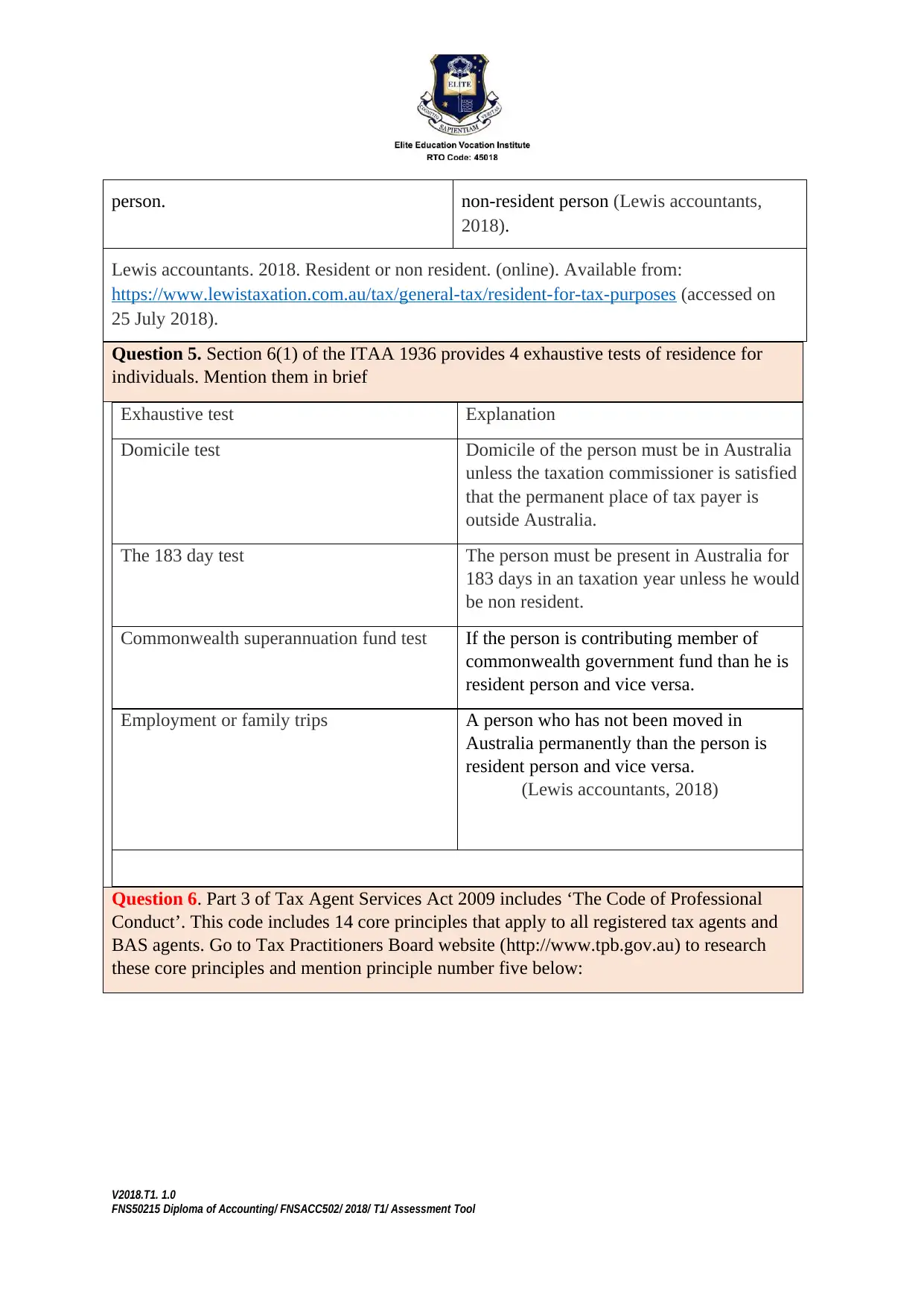
person. non-resident person (Lewis accountants,
2018).
Lewis accountants. 2018. Resident or non resident. (online). Available from:
https://www.lewistaxation.com.au/tax/general-tax/resident-for-tax-purposes (accessed on
25 July 2018).
Question 5. Section 6(1) of the ITAA 1936 provides 4 exhaustive tests of residence for
individuals. Mention them in brief
Exhaustive test Explanation
Domicile test Domicile of the person must be in Australia
unless the taxation commissioner is satisfied
that the permanent place of tax payer is
outside Australia.
The 183 day test The person must be present in Australia for
183 days in an taxation year unless he would
be non resident.
Commonwealth superannuation fund test If the person is contributing member of
commonwealth government fund than he is
resident person and vice versa.
Employment or family trips A person who has not been moved in
Australia permanently than the person is
resident person and vice versa.
(Lewis accountants, 2018)
Question 6. Part 3 of Tax Agent Services Act 2009 includes ‘The Code of Professional
Conduct’. This code includes 14 core principles that apply to all registered tax agents and
BAS agents. Go to Tax Practitioners Board website (http://www.tpb.gov.au) to research
these core principles and mention principle number five below:
V2018.T1. 1.0
FNS50215 Diploma of Accounting/ FNSACC502/ 2018/ T1/ Assessment Tool
2018).
Lewis accountants. 2018. Resident or non resident. (online). Available from:
https://www.lewistaxation.com.au/tax/general-tax/resident-for-tax-purposes (accessed on
25 July 2018).
Question 5. Section 6(1) of the ITAA 1936 provides 4 exhaustive tests of residence for
individuals. Mention them in brief
Exhaustive test Explanation
Domicile test Domicile of the person must be in Australia
unless the taxation commissioner is satisfied
that the permanent place of tax payer is
outside Australia.
The 183 day test The person must be present in Australia for
183 days in an taxation year unless he would
be non resident.
Commonwealth superannuation fund test If the person is contributing member of
commonwealth government fund than he is
resident person and vice versa.
Employment or family trips A person who has not been moved in
Australia permanently than the person is
resident person and vice versa.
(Lewis accountants, 2018)
Question 6. Part 3 of Tax Agent Services Act 2009 includes ‘The Code of Professional
Conduct’. This code includes 14 core principles that apply to all registered tax agents and
BAS agents. Go to Tax Practitioners Board website (http://www.tpb.gov.au) to research
these core principles and mention principle number five below:
V2018.T1. 1.0
FNS50215 Diploma of Accounting/ FNSACC502/ 2018/ T1/ Assessment Tool
Paraphrase This Document
Need a fresh take? Get an instant paraphrase of this document with our AI Paraphraser
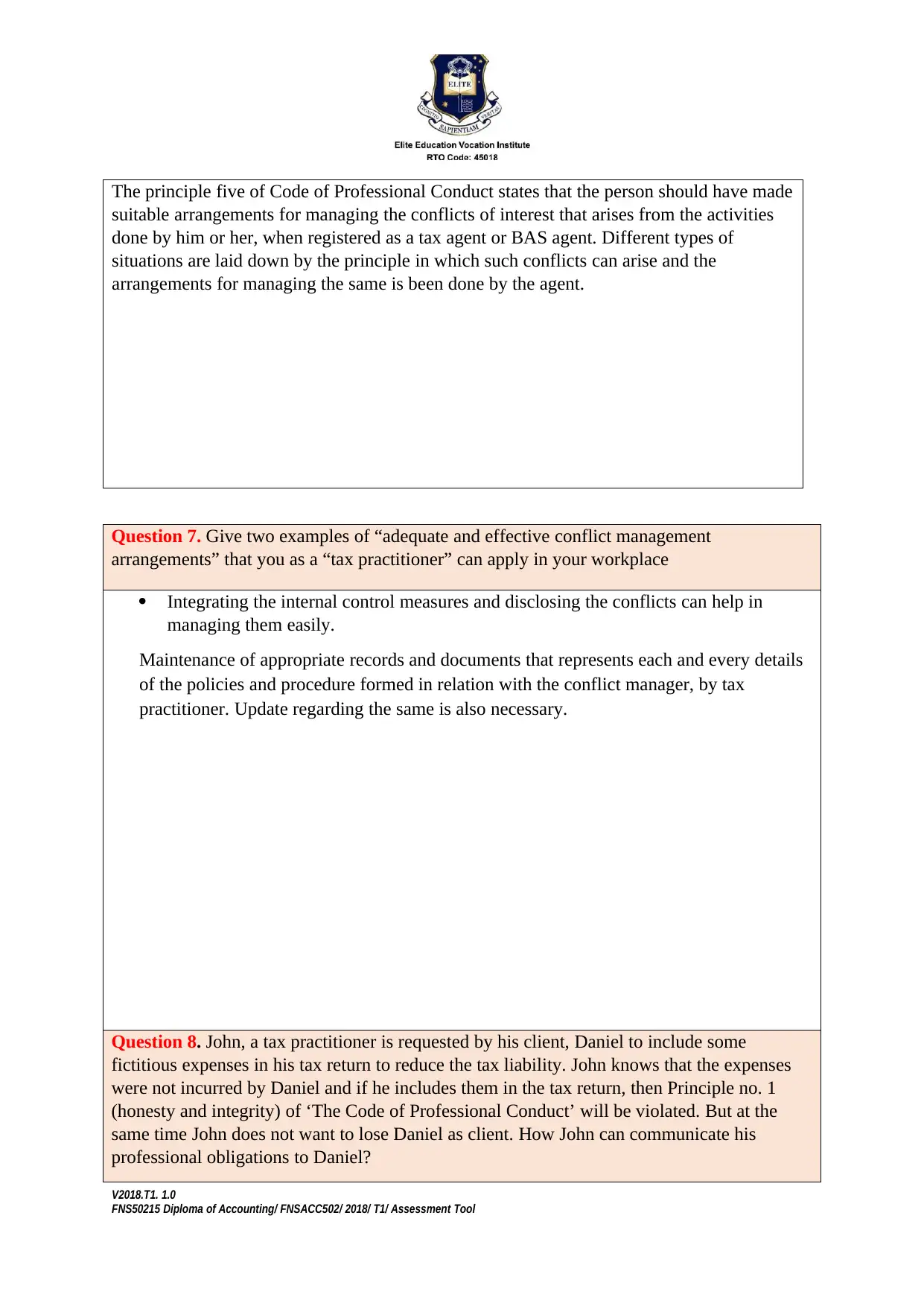
The principle five of Code of Professional Conduct states that the person should have made
suitable arrangements for managing the conflicts of interest that arises from the activities
done by him or her, when registered as a tax agent or BAS agent. Different types of
situations are laid down by the principle in which such conflicts can arise and the
arrangements for managing the same is been done by the agent.
Question 7. Give two examples of “adequate and effective conflict management
arrangements” that you as a “tax practitioner” can apply in your workplace
Integrating the internal control measures and disclosing the conflicts can help in
managing them easily.
Maintenance of appropriate records and documents that represents each and every details
of the policies and procedure formed in relation with the conflict manager, by tax
practitioner. Update regarding the same is also necessary.
Question 8. John, a tax practitioner is requested by his client, Daniel to include some
fictitious expenses in his tax return to reduce the tax liability. John knows that the expenses
were not incurred by Daniel and if he includes them in the tax return, then Principle no. 1
(honesty and integrity) of ‘The Code of Professional Conduct’ will be violated. But at the
same time John does not want to lose Daniel as client. How John can communicate his
professional obligations to Daniel?
V2018.T1. 1.0
FNS50215 Diploma of Accounting/ FNSACC502/ 2018/ T1/ Assessment Tool
suitable arrangements for managing the conflicts of interest that arises from the activities
done by him or her, when registered as a tax agent or BAS agent. Different types of
situations are laid down by the principle in which such conflicts can arise and the
arrangements for managing the same is been done by the agent.
Question 7. Give two examples of “adequate and effective conflict management
arrangements” that you as a “tax practitioner” can apply in your workplace
Integrating the internal control measures and disclosing the conflicts can help in
managing them easily.
Maintenance of appropriate records and documents that represents each and every details
of the policies and procedure formed in relation with the conflict manager, by tax
practitioner. Update regarding the same is also necessary.
Question 8. John, a tax practitioner is requested by his client, Daniel to include some
fictitious expenses in his tax return to reduce the tax liability. John knows that the expenses
were not incurred by Daniel and if he includes them in the tax return, then Principle no. 1
(honesty and integrity) of ‘The Code of Professional Conduct’ will be violated. But at the
same time John does not want to lose Daniel as client. How John can communicate his
professional obligations to Daniel?
V2018.T1. 1.0
FNS50215 Diploma of Accounting/ FNSACC502/ 2018/ T1/ Assessment Tool
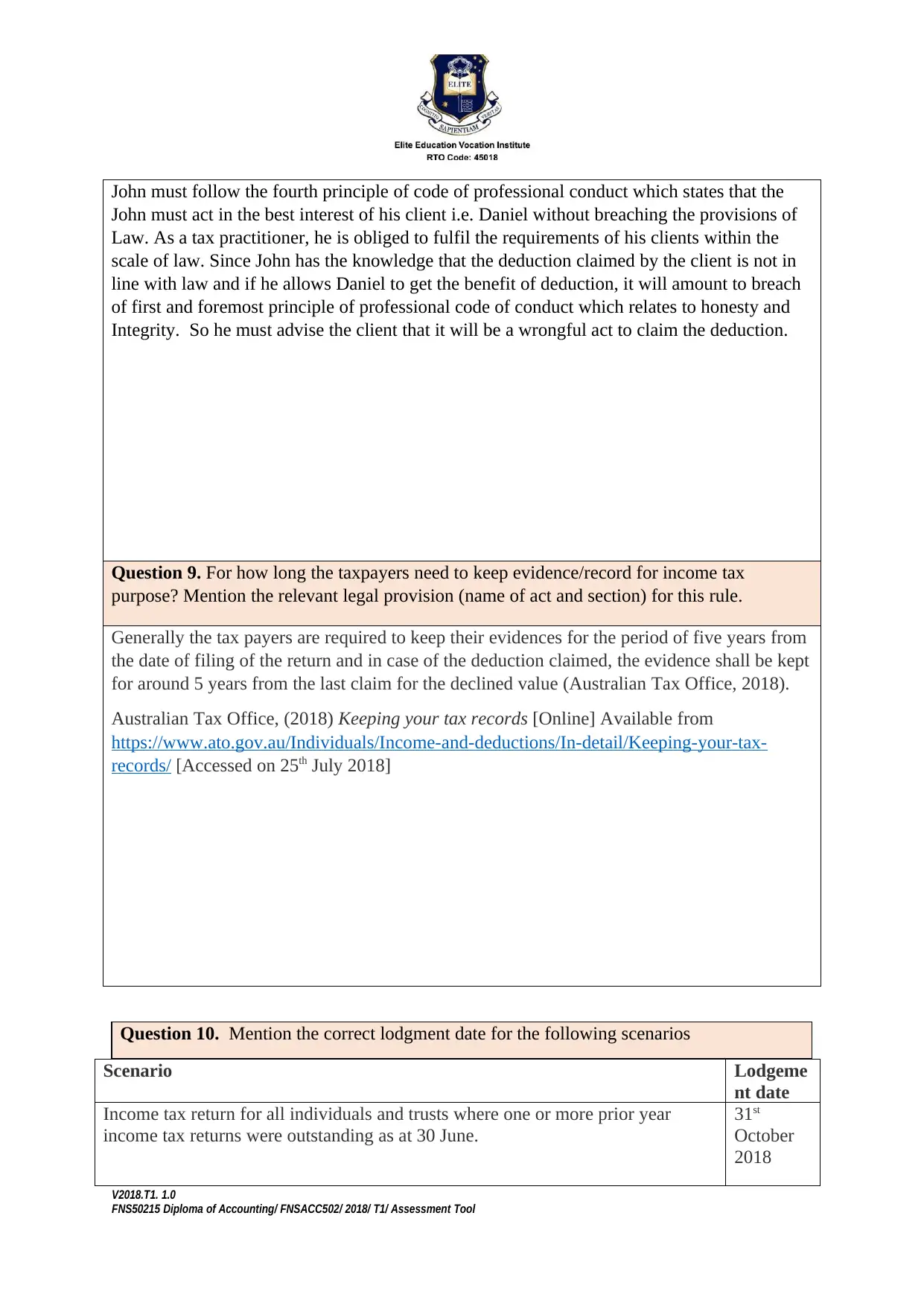
John must follow the fourth principle of code of professional conduct which states that the
John must act in the best interest of his client i.e. Daniel without breaching the provisions of
Law. As a tax practitioner, he is obliged to fulfil the requirements of his clients within the
scale of law. Since John has the knowledge that the deduction claimed by the client is not in
line with law and if he allows Daniel to get the benefit of deduction, it will amount to breach
of first and foremost principle of professional code of conduct which relates to honesty and
Integrity. So he must advise the client that it will be a wrongful act to claim the deduction.
Question 9. For how long the taxpayers need to keep evidence/record for income tax
purpose? Mention the relevant legal provision (name of act and section) for this rule.
Generally the tax payers are required to keep their evidences for the period of five years from
the date of filing of the return and in case of the deduction claimed, the evidence shall be kept
for around 5 years from the last claim for the declined value (Australian Tax Office, 2018).
Australian Tax Office, (2018) Keeping your tax records [Online] Available from
https://www.ato.gov.au/Individuals/Income-and-deductions/In-detail/Keeping-your-tax-
records/ [Accessed on 25th July 2018]
Question 10. Mention the correct lodgment date for the following scenarios
Scenario Lodgeme
nt date
Income tax return for all individuals and trusts where one or more prior year
income tax returns were outstanding as at 30 June.
31st
October
2018
V2018.T1. 1.0
FNS50215 Diploma of Accounting/ FNSACC502/ 2018/ T1/ Assessment Tool
John must act in the best interest of his client i.e. Daniel without breaching the provisions of
Law. As a tax practitioner, he is obliged to fulfil the requirements of his clients within the
scale of law. Since John has the knowledge that the deduction claimed by the client is not in
line with law and if he allows Daniel to get the benefit of deduction, it will amount to breach
of first and foremost principle of professional code of conduct which relates to honesty and
Integrity. So he must advise the client that it will be a wrongful act to claim the deduction.
Question 9. For how long the taxpayers need to keep evidence/record for income tax
purpose? Mention the relevant legal provision (name of act and section) for this rule.
Generally the tax payers are required to keep their evidences for the period of five years from
the date of filing of the return and in case of the deduction claimed, the evidence shall be kept
for around 5 years from the last claim for the declined value (Australian Tax Office, 2018).
Australian Tax Office, (2018) Keeping your tax records [Online] Available from
https://www.ato.gov.au/Individuals/Income-and-deductions/In-detail/Keeping-your-tax-
records/ [Accessed on 25th July 2018]
Question 10. Mention the correct lodgment date for the following scenarios
Scenario Lodgeme
nt date
Income tax return for all individuals and trusts where one or more prior year
income tax returns were outstanding as at 30 June.
31st
October
2018
V2018.T1. 1.0
FNS50215 Diploma of Accounting/ FNSACC502/ 2018/ T1/ Assessment Tool
⊘ This is a preview!⊘
Do you want full access?
Subscribe today to unlock all pages.

Trusted by 1+ million students worldwide
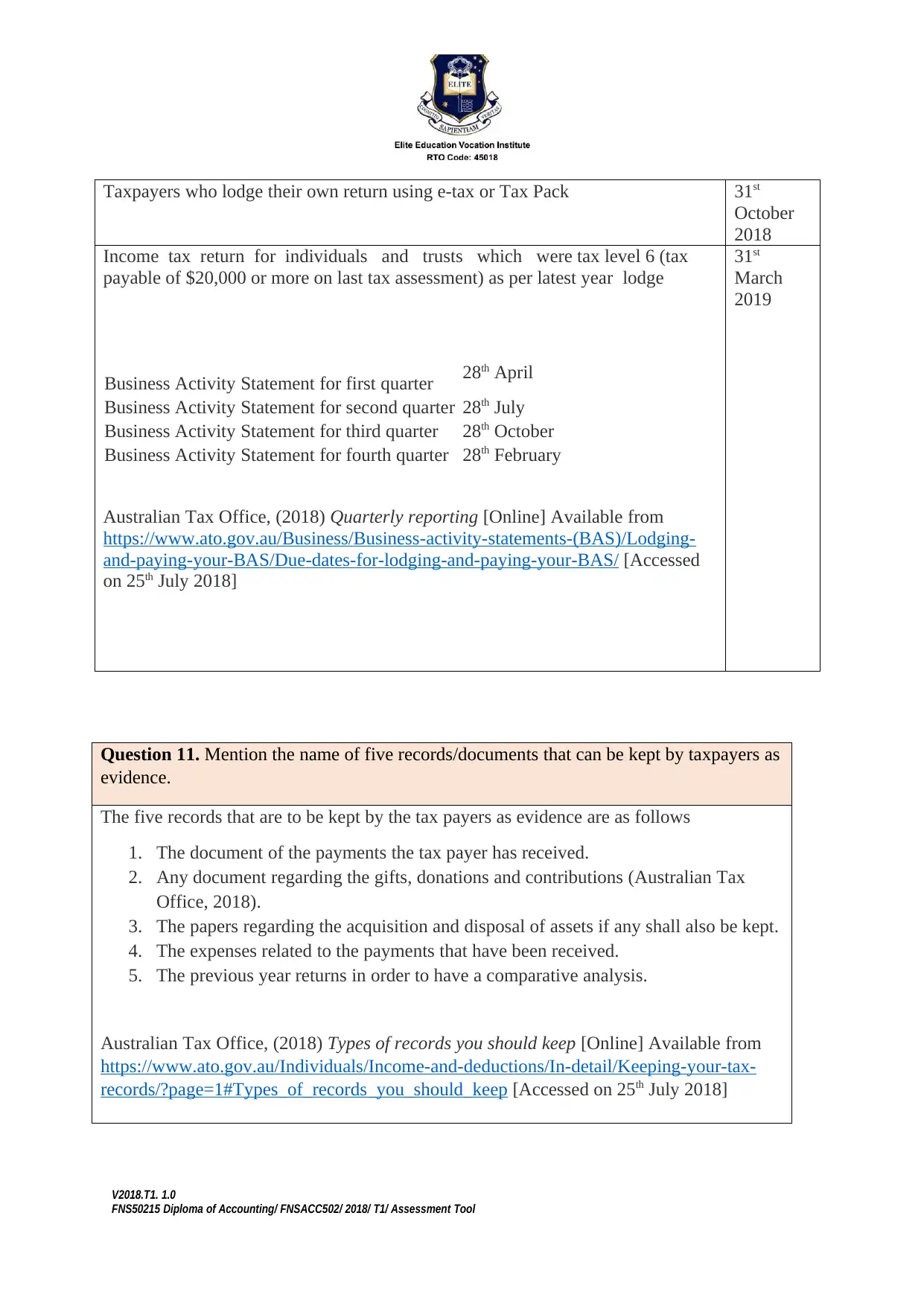
Taxpayers who lodge their own return using e-tax or Tax Pack 31st
October
2018
Income tax return for individuals and trusts which were tax level 6 (tax
payable of $20,000 or more on last tax assessment) as per latest year lodge
Business Activity Statement for first quarter 28th April
Business Activity Statement for second quarter 28th July
Business Activity Statement for third quarter 28th October
Business Activity Statement for fourth quarter 28th February
Australian Tax Office, (2018) Quarterly reporting [Online] Available from
https://www.ato.gov.au/Business/Business-activity-statements-(BAS)/Lodging-
and-paying-your-BAS/Due-dates-for-lodging-and-paying-your-BAS/ [Accessed
on 25th July 2018]
31st
March
2019
Question 11. Mention the name of five records/documents that can be kept by taxpayers as
evidence.
The five records that are to be kept by the tax payers as evidence are as follows
1. The document of the payments the tax payer has received.
2. Any document regarding the gifts, donations and contributions (Australian Tax
Office, 2018).
3. The papers regarding the acquisition and disposal of assets if any shall also be kept.
4. The expenses related to the payments that have been received.
5. The previous year returns in order to have a comparative analysis.
Australian Tax Office, (2018) Types of records you should keep [Online] Available from
https://www.ato.gov.au/Individuals/Income-and-deductions/In-detail/Keeping-your-tax-
records/?page=1#Types_of_records_you_should_keep [Accessed on 25th July 2018]
V2018.T1. 1.0
FNS50215 Diploma of Accounting/ FNSACC502/ 2018/ T1/ Assessment Tool
October
2018
Income tax return for individuals and trusts which were tax level 6 (tax
payable of $20,000 or more on last tax assessment) as per latest year lodge
Business Activity Statement for first quarter 28th April
Business Activity Statement for second quarter 28th July
Business Activity Statement for third quarter 28th October
Business Activity Statement for fourth quarter 28th February
Australian Tax Office, (2018) Quarterly reporting [Online] Available from
https://www.ato.gov.au/Business/Business-activity-statements-(BAS)/Lodging-
and-paying-your-BAS/Due-dates-for-lodging-and-paying-your-BAS/ [Accessed
on 25th July 2018]
31st
March
2019
Question 11. Mention the name of five records/documents that can be kept by taxpayers as
evidence.
The five records that are to be kept by the tax payers as evidence are as follows
1. The document of the payments the tax payer has received.
2. Any document regarding the gifts, donations and contributions (Australian Tax
Office, 2018).
3. The papers regarding the acquisition and disposal of assets if any shall also be kept.
4. The expenses related to the payments that have been received.
5. The previous year returns in order to have a comparative analysis.
Australian Tax Office, (2018) Types of records you should keep [Online] Available from
https://www.ato.gov.au/Individuals/Income-and-deductions/In-detail/Keeping-your-tax-
records/?page=1#Types_of_records_you_should_keep [Accessed on 25th July 2018]
V2018.T1. 1.0
FNS50215 Diploma of Accounting/ FNSACC502/ 2018/ T1/ Assessment Tool
Paraphrase This Document
Need a fresh take? Get an instant paraphrase of this document with our AI Paraphraser
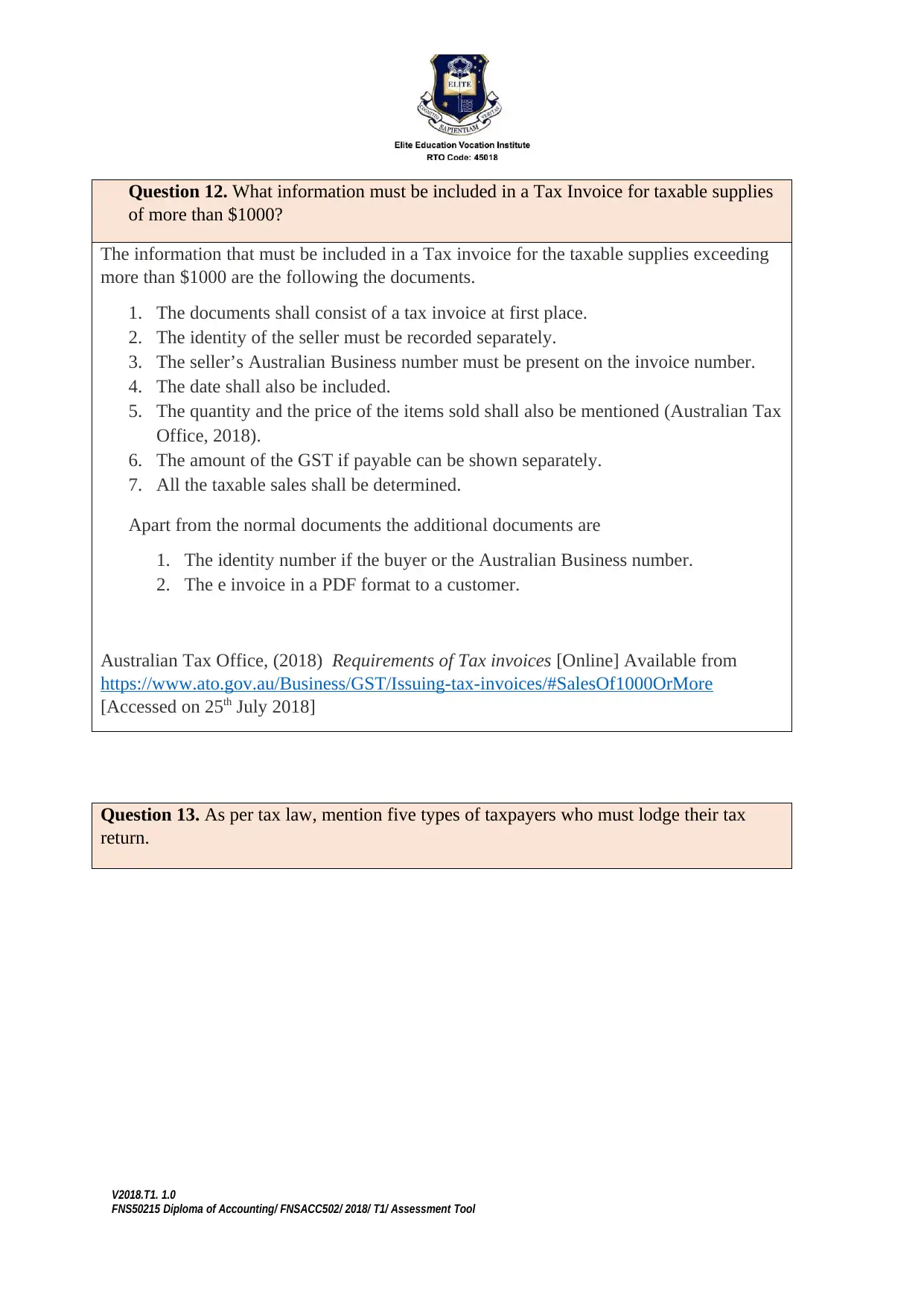
Question 12. What information must be included in a Tax Invoice for taxable supplies
of more than $1000?
The information that must be included in a Tax invoice for the taxable supplies exceeding
more than $1000 are the following the documents.
1. The documents shall consist of a tax invoice at first place.
2. The identity of the seller must be recorded separately.
3. The seller’s Australian Business number must be present on the invoice number.
4. The date shall also be included.
5. The quantity and the price of the items sold shall also be mentioned (Australian Tax
Office, 2018).
6. The amount of the GST if payable can be shown separately.
7. All the taxable sales shall be determined.
Apart from the normal documents the additional documents are
1. The identity number if the buyer or the Australian Business number.
2. The e invoice in a PDF format to a customer.
Australian Tax Office, (2018) Requirements of Tax invoices [Online] Available from
https://www.ato.gov.au/Business/GST/Issuing-tax-invoices/#SalesOf1000OrMore
[Accessed on 25th July 2018]
Question 13. As per tax law, mention five types of taxpayers who must lodge their tax
return.
V2018.T1. 1.0
FNS50215 Diploma of Accounting/ FNSACC502/ 2018/ T1/ Assessment Tool
of more than $1000?
The information that must be included in a Tax invoice for the taxable supplies exceeding
more than $1000 are the following the documents.
1. The documents shall consist of a tax invoice at first place.
2. The identity of the seller must be recorded separately.
3. The seller’s Australian Business number must be present on the invoice number.
4. The date shall also be included.
5. The quantity and the price of the items sold shall also be mentioned (Australian Tax
Office, 2018).
6. The amount of the GST if payable can be shown separately.
7. All the taxable sales shall be determined.
Apart from the normal documents the additional documents are
1. The identity number if the buyer or the Australian Business number.
2. The e invoice in a PDF format to a customer.
Australian Tax Office, (2018) Requirements of Tax invoices [Online] Available from
https://www.ato.gov.au/Business/GST/Issuing-tax-invoices/#SalesOf1000OrMore
[Accessed on 25th July 2018]
Question 13. As per tax law, mention five types of taxpayers who must lodge their tax
return.
V2018.T1. 1.0
FNS50215 Diploma of Accounting/ FNSACC502/ 2018/ T1/ Assessment Tool
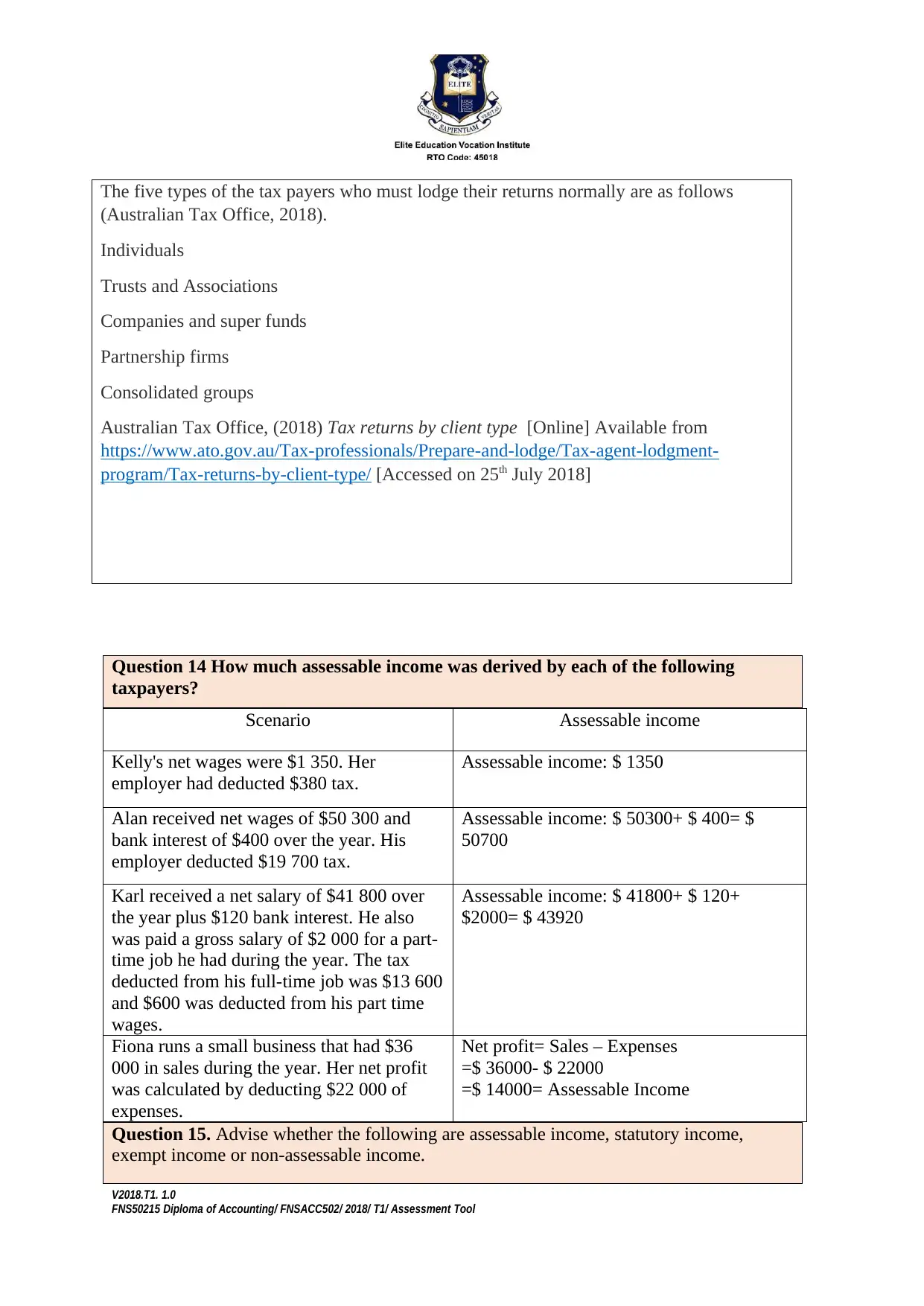
The five types of the tax payers who must lodge their returns normally are as follows
(Australian Tax Office, 2018).
Individuals
Trusts and Associations
Companies and super funds
Partnership firms
Consolidated groups
Australian Tax Office, (2018) Tax returns by client type [Online] Available from
https://www.ato.gov.au/Tax-professionals/Prepare-and-lodge/Tax-agent-lodgment-
program/Tax-returns-by-client-type/ [Accessed on 25th July 2018]
Question 14 How much assessable income was derived by each of the following
taxpayers?
Scenario Assessable income
Kelly's net wages were $1 350. Her
employer had deducted $380 tax.
Assessable income: $ 1350
Alan received net wages of $50 300 and
bank interest of $400 over the year. His
employer deducted $19 700 tax.
Assessable income: $ 50300+ $ 400= $
50700
Karl received a net salary of $41 800 over
the year plus $120 bank interest. He also
was paid a gross salary of $2 000 for a part-
time job he had during the year. The tax
deducted from his full-time job was $13 600
and $600 was deducted from his part time
wages.
Assessable income: $ 41800+ $ 120+
$2000= $ 43920
Fiona runs a small business that had $36
000 in sales during the year. Her net profit
was calculated by deducting $22 000 of
expenses.
Net profit= Sales – Expenses
=$ 36000- $ 22000
=$ 14000= Assessable Income
Question 15. Advise whether the following are assessable income, statutory income,
exempt income or non-assessable income.
V2018.T1. 1.0
FNS50215 Diploma of Accounting/ FNSACC502/ 2018/ T1/ Assessment Tool
(Australian Tax Office, 2018).
Individuals
Trusts and Associations
Companies and super funds
Partnership firms
Consolidated groups
Australian Tax Office, (2018) Tax returns by client type [Online] Available from
https://www.ato.gov.au/Tax-professionals/Prepare-and-lodge/Tax-agent-lodgment-
program/Tax-returns-by-client-type/ [Accessed on 25th July 2018]
Question 14 How much assessable income was derived by each of the following
taxpayers?
Scenario Assessable income
Kelly's net wages were $1 350. Her
employer had deducted $380 tax.
Assessable income: $ 1350
Alan received net wages of $50 300 and
bank interest of $400 over the year. His
employer deducted $19 700 tax.
Assessable income: $ 50300+ $ 400= $
50700
Karl received a net salary of $41 800 over
the year plus $120 bank interest. He also
was paid a gross salary of $2 000 for a part-
time job he had during the year. The tax
deducted from his full-time job was $13 600
and $600 was deducted from his part time
wages.
Assessable income: $ 41800+ $ 120+
$2000= $ 43920
Fiona runs a small business that had $36
000 in sales during the year. Her net profit
was calculated by deducting $22 000 of
expenses.
Net profit= Sales – Expenses
=$ 36000- $ 22000
=$ 14000= Assessable Income
Question 15. Advise whether the following are assessable income, statutory income,
exempt income or non-assessable income.
V2018.T1. 1.0
FNS50215 Diploma of Accounting/ FNSACC502/ 2018/ T1/ Assessment Tool
⊘ This is a preview!⊘
Do you want full access?
Subscribe today to unlock all pages.

Trusted by 1+ million students worldwide
1 out of 20
Related Documents
Your All-in-One AI-Powered Toolkit for Academic Success.
+13062052269
info@desklib.com
Available 24*7 on WhatsApp / Email
![[object Object]](/_next/static/media/star-bottom.7253800d.svg)
Unlock your academic potential
Copyright © 2020–2025 A2Z Services. All Rights Reserved. Developed and managed by ZUCOL.




